On Thursday, another UEFA Champions League semi-final was played as Real Madrid overcame Man City despite being two goals down in the 88th minute. Almost everyone admitted that Pep Guardiola’s Man City were the side when they met at the Etihad Stadium, but when they played each other again just one week later, the margin of both sides was smaller than expected as we saw Carlo Ancelotti making some wise changes to help his players.
This tactical analysis will explain the key tactics of both head coaches that had an impact in the game.
Lineups
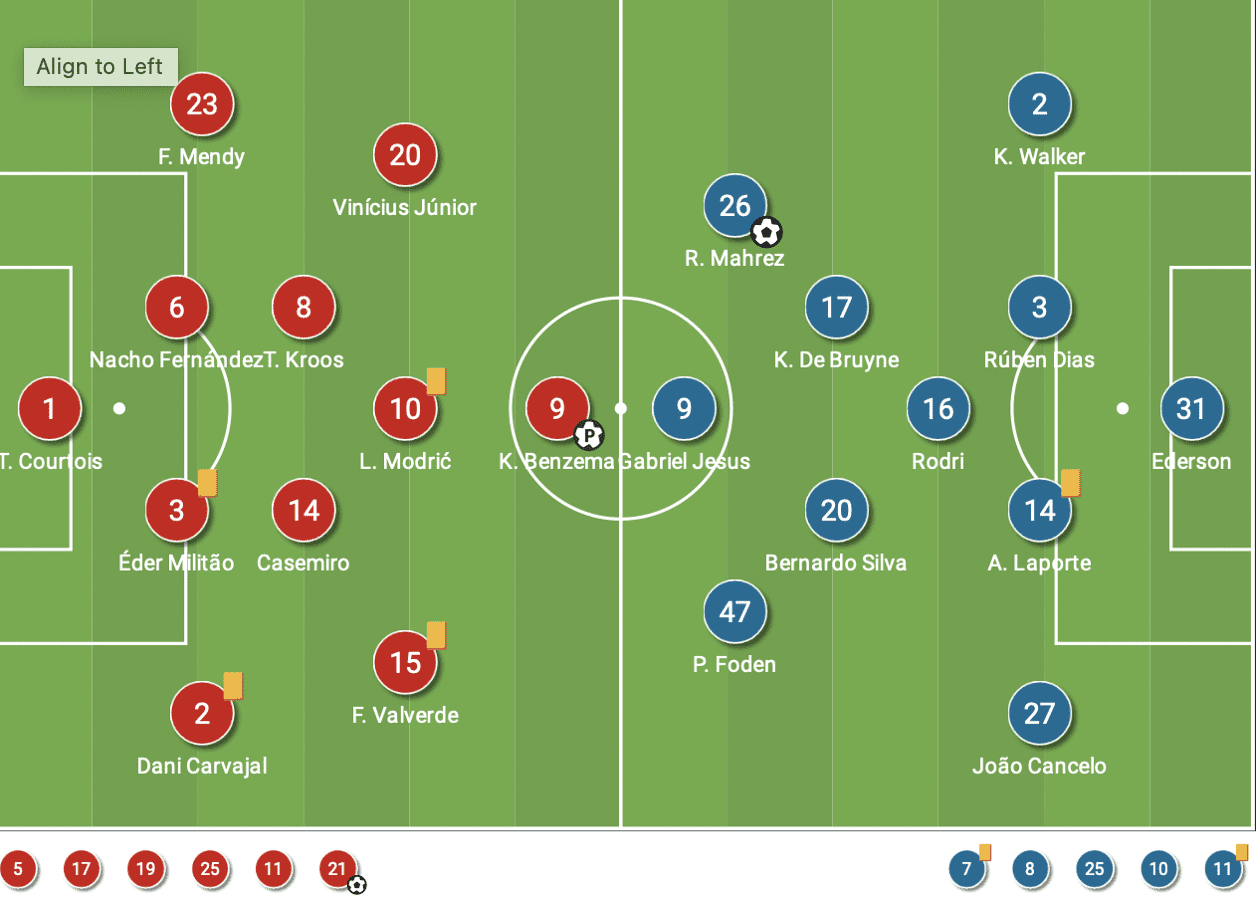
Real Madrid came with only slight changes in the game as Nacho Fernández replaced the injured David Alaba as the partner of Éder Militão, and they added Casemiro into the midfield by dropping Rodrygo. Instead, it was Federico Valverde who played as the right-winger and kept the energy and defensive balance for the side.
For City, they had Kyle Walker barely recovered from injury – he started and they also had João Cancelo returning from suspension who played left-back. The rest were the same who played well in the 4-3 victory, as the likes of Jack Grealish, Raheem Sterling, and İlkay Gündoğan all started on the bench.
Madrid learnt in the build-up
In the first leg, Madrid conceded many chances from transitions because they gave away the ball to City in their half very often, including the opener of Kevin De Bruyne. Ancelotti was smart enough to avoid the same situation from happening again by adjusting the build-up structure and instructions slightly.
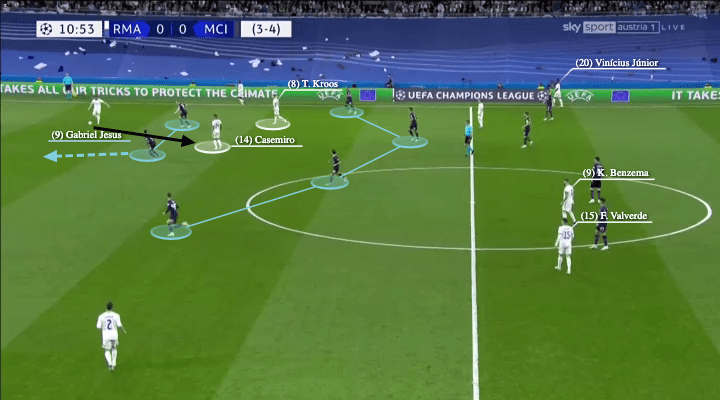
Firstly, in terms of the offensive heights, Ancelotti felt that it was unnecessary to maintain it on both sides with Rodrygo and Vinícius Júnior, that’s why he chose Valverde who could be a bit hybrid, go into space and also stay high.
Another part of the setup, was clever as they played with two deep midfielders, as now Casemiro and Toni Kroos could watch each other and be more flexible with their positions. For example, when City tried to press with a 4-4-2 as shown above, they could not do it easily as they did in the first leg as there are two midfielder options given to centre-backs. When Gabriel Jesus jumped out too early to press, Casemiro could receive despite De Bruyne covering Kroos with his body angle.
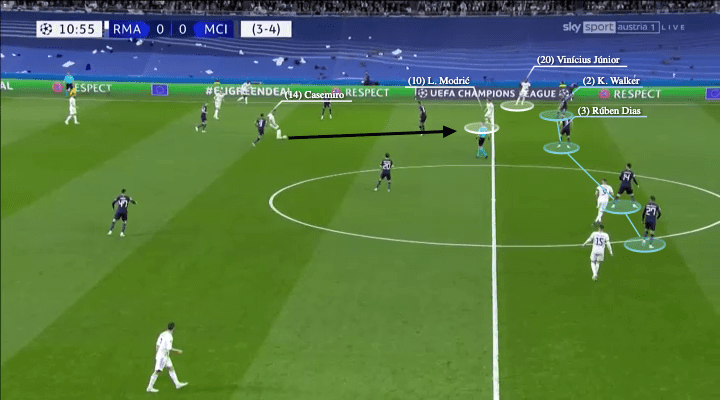
And as the ball reached Casemiro, you could see a Madrid move was on because they have a clear way of going behind City’s high line. In this game, Karim Benzema was more disciplined to stay in his striker position, alongside with Vinícius who also stayed higher to use his pace and 1v1 ability. But City were also cautious with Rúben Dias stepping out less frequent than last game in the first period, as they did not want to isolate Walker in those situations, so the tone of Madrid’s attack was more or less set in this way. When they have the chance, they can find Luka Modrić between the lines, but then the next action must be going behind and releasing the runners, if not using the big switch in the first move.
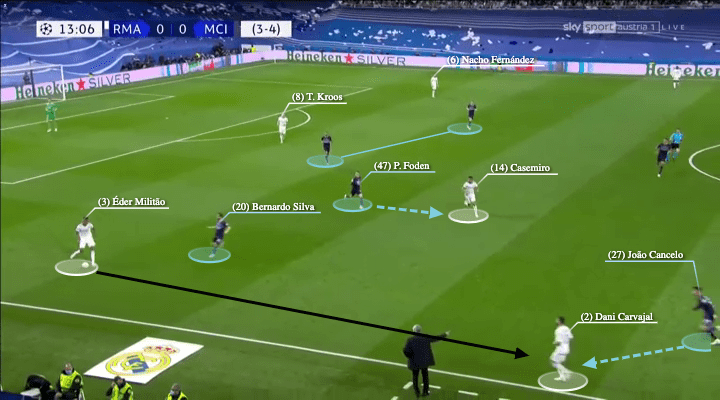
Madrid are also very flexible with its structure, as we saw Kroos could drop into the first line to give himself more space in the construction as shown above. Also, Ancelotti wanted his players to be braver and push higher, not to squeeze themselves for short passes in the build-up as they needed to open the shape for more spaces to play. Therefore, Ferland Mendy and Dani Carvajal took up higher positions in advanced areas more often than in the first game.
Here, because of the open Madrid shape in the attack, they were able to come out with a good sequence, as Militão was wide enough to pass before Bernardo Silva accessed him, but you could also see Casemiro’s willingness to play as he moved into space when the pass was made, so he arrived when the ball reached Carvajal.
But this example also showed City were below par, especially in the first half, which might not be a tactical reason as the atmosphere of the stadium could also be a factor. Individually, the Citizens were unable to shut down the angle of the pass or be intense enough to win the ball back, as Cancelo and Phil Foden both missed their timing to limit the angle of opponents in this example.
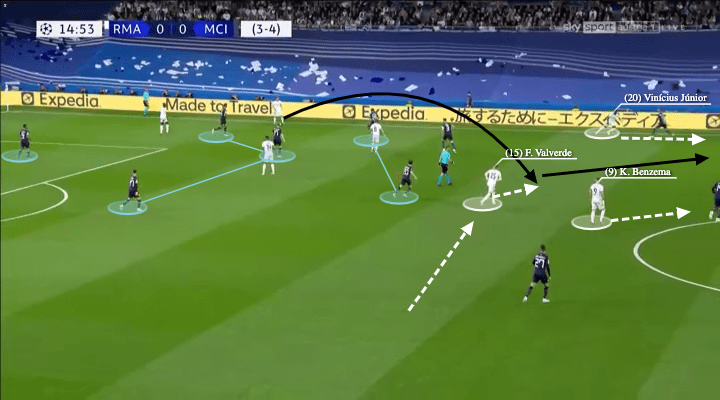
Here, the next example shows the versatile Valverde in Madrid’s structure. He was a midfielder but being placed as the right-winger, but of course, Ancelotti wanted to use his energy, the capacity of the run, and willingness to play in space to give the team dynamism, as we saw the Uruguayan player move into spaces behind the City press line to receive.
In terms of behaviour, Madrid were not sloppy compared to the first game, as they were alert that they should go longer with more diagonals behind the press line of City if Pep’s men locked them high up on the pitch. That behaviour or you can describe it as a change of mindset, was the reason that City could not generate too many TDA chances throughout the game.
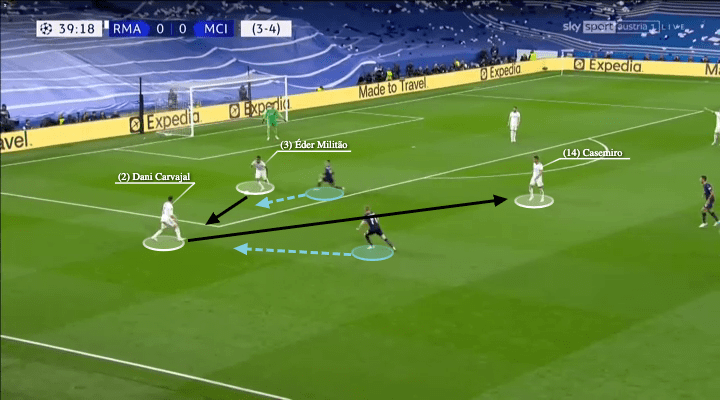
Again, we want to emphasize that Madrid players showed incredible willingness to play. They move the ball better, but that was not only attributed to the better structure only, it was also the individual behaviour, they were more proactively to receive and play one-two move. This means after a pass was made, the passer would not stop, but then he moved forward to receive in space immediately regardless of his position.
For example, here, we saw Carvajal received from Militão from deep and played it to Casemiro, who was in space. Then, he did not stop and continued his run.
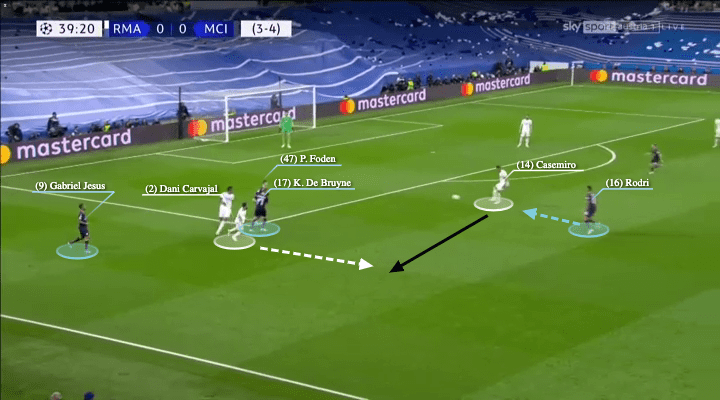
So, the situation became favourable to Madrid as De Bruyne stopped, but Carvajal continued. Even though Rodrigo Hernández moved out to press Casemiro, City were usually late to close the angle and Madrid were also alert to use the one-touch pass to evade pressure. Then, Carvajal received again in opened spaces and now Madrid could go all the way.
But when City took over more possession and control of the game, Madrid barely constructed anything in the second half because they did not have the ball, you could not conclude the goals as something was well-drilled in the structure.
City solved the pressing, eventually
In the first half, City might be a bit nervous and they did not look like themselves. With the ball, they did not create a lot of good chances, part of the reason was the Madrid defending was spot on and more careful than the first leg, but another reason would be the positional structure of City was not staggered enough to create the dynamics.
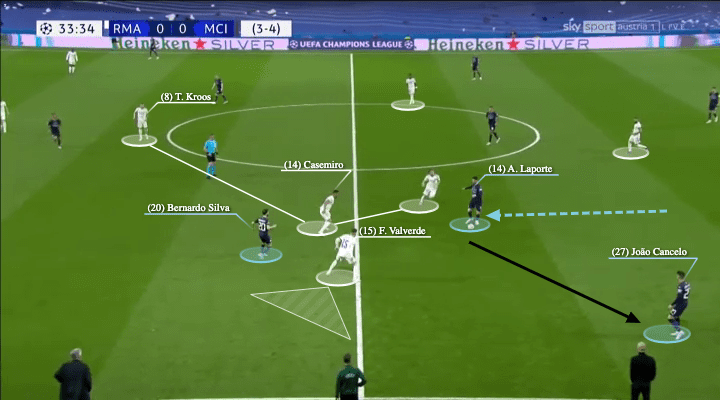
In the first game, in Madrid’s 4-1-4-1, Kroos’ position was very exposed as he was always isolated in his position. Ancelotti did not repeat the same situation as he balanced the shape with more of a 4-2-3-1 as shown on the team sheet, and also with Valverde’s good defensive efforts as shown here.
Although Aymeric Laporte was good on the ball, Madrid felt that they could afford some room for the Frenchman defender as long as he could not send the ball forward. Firstly, Madrid allowed the 6 to step up but the midfielder on the other side, as Kroos’ position indicated above, must be there to balance and cover. So even if Casemiro left his position, there was still someone in front of the centre-backs.
And more importantly, was Valverde’s body angle. He should not be marking Cancelo but defending the space by using his body angle to cover that. They felt okay to let Cancelo receive outside of the block as shown above, as long as City could not put the ball behind them.
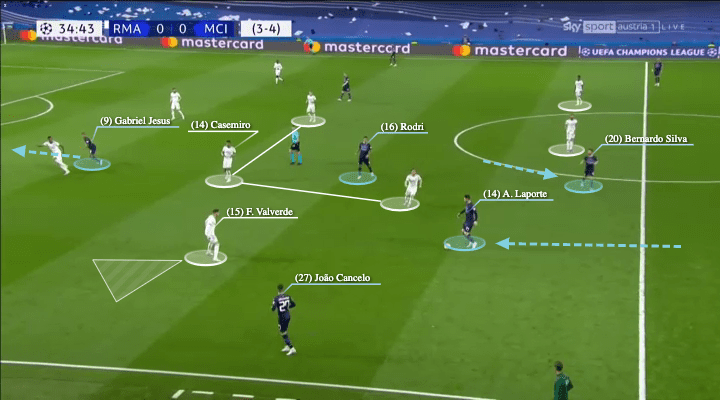
For City, the problem in their structure was losing the occupation of both half-space. When Silva, who played outside of the block and deeper in the first half, Pep’s side did not have enough players between the lines as only De Bruyne was there. Jesus and Foden were mostly making the forward runs and the mindset was more of going behind, so when Laporte carried the ball forward, as shown above, no one was there. On top of that, the Madrid structure of Kroos and Casemiro helping each other was protecting that area as well.
Also, as explained in the above analysis, the body angle of Valverde was crucial to close that space, so Cancelo could not move into an advanced position to receive as the passing lane was blocked. The Portuguese international could only have the ball in deeper areas.
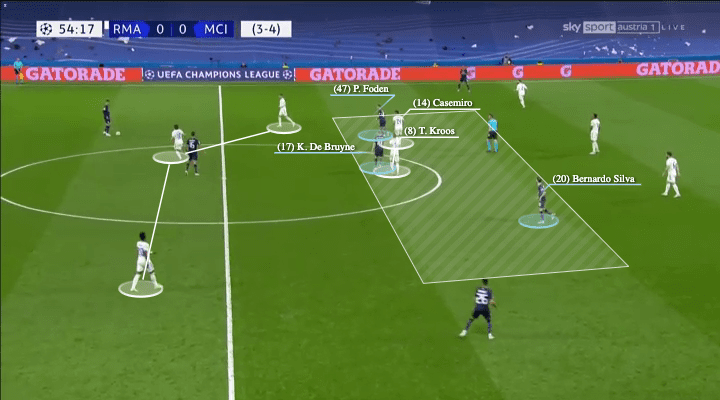
And that situation was eased by the tactical changes of Pep in the game. Around 30 something minutes, Foden and Jesus swapped positions as the Foden was much better playing in spaces, so he could help the midfield more while Jesus maintained the wide threat outside.
Then, it is possible to create favourable conditions in the midfield as City also released Silva to run and move into spaces. The message might not be clear from the touchline, but in the second half, it was very clear that the Citizens took over by playing between the lines to control the game.
For instance, even though Madrid could deploy a 4-2-3-1 defensive shape when City put the players in spaces, they could create conditionally 3v2 by occupying more vertical zones, especially both half-spaces with Silva, Foden, and De Bruyne as shown above.
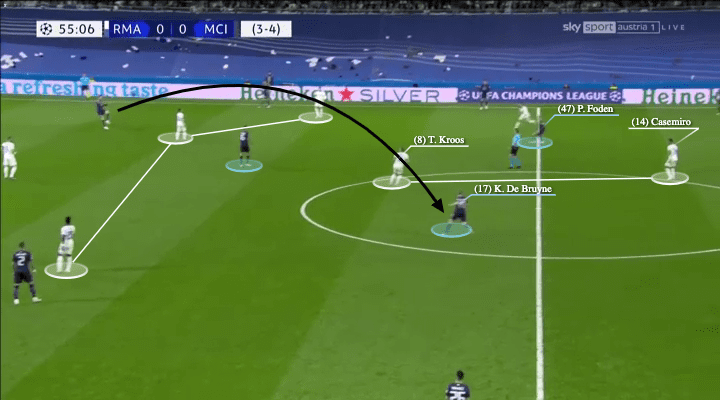
Then you could also see the players working in both half-spaces could interact and break the Madrid structure, as the position of Foden, Rodri, and De Bruyne shown here, they occupied different zones vertically and horizontally to split the Madrid 6, as now Kroos and Casemiro were in awkward positions and in the same vertical chain. Then, it was Laporte’s quality to find De Bruyne diagonally.
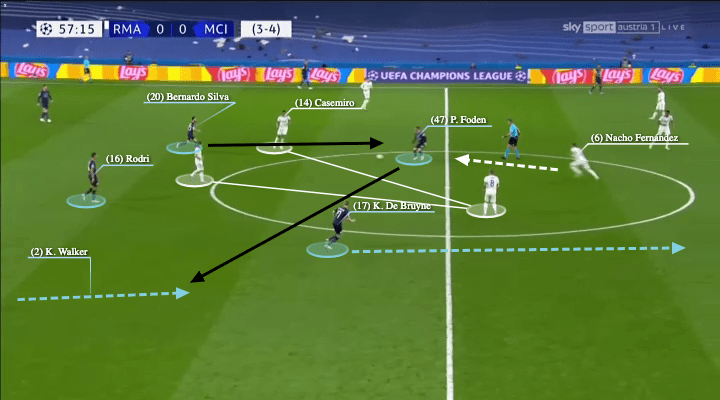
Madrid could still use the centre-back to close the midfield, trying to balance the number, but then it gave City the chance to break the last line as the gaps were exposed. Here, Nacho stepped up to press Foden, but again, because of the staggered shape, City had good sequence to evade press as Foden connected Walker here. At the same time, De Bruyne dashed forward and you will see the impact in the next image.

And because Nacho was out, the back four of Madrid was incomplete and the gap was opened. Here, Walker sliced the vertical ball to De Bruyne, who ran into spaces behind Nacho. It was a good final third entry with threat that was generated from the midfield structure we’ve shown above.
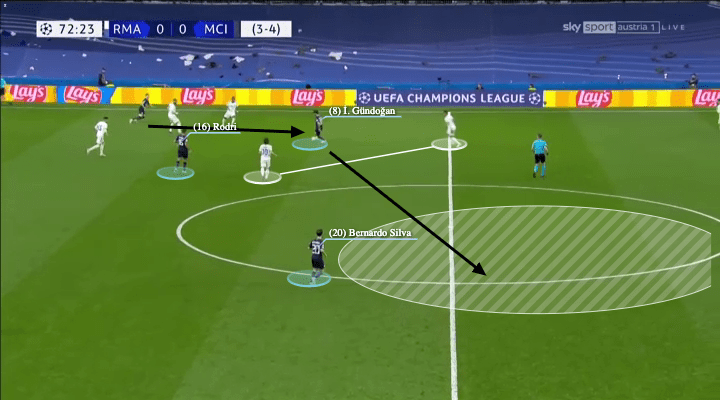
Some might blame Pep for replacing De Bruyne, but that was not a stupid move given the situation of the game and the characteristics of the players. De Bruyne was like a knife who could stab, but that stabbing action itself also implied he was very forward-thinking minded, and a bit aggressive. In the last part of the game, Gündoğan came in and he was a good communicator who could play in spaces, taking more touches to decide the rhythm. Actually, the German international did nothing wrong in this part of the game and he even created the goal.
In fact, Riyad Mahrez’s goal was attributed to the new midfield structure as we explained. As we have shown in the above screenshot, before the goal, it was the interaction of both half-spaces (Gündoğan and Silva) to break the defence.
Conclusion
It was a very crazy game, who could believe Madrid were two-goal down and they just used those moments to turn the tie around completely. Tactically, both head coaches had worked very hard to cancel each other out with good effects being seen, but we also think that the goals were not a result of tactical moves. Instead, it could be mental as City collapsed in a very short period. Madrid had some luck but as we explained in this analysis, they showed great disciplinary and careful tactics to encounter City, and now they were heading to Paris for another final.




Comments